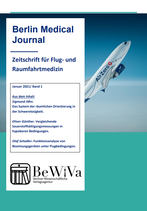Archiv
-

BerMedJ-Berlin Medical Journal
Bd. 6 Nr. 1 (2024)Der Band 6 fügt erneut interdisziplinäre und interprofessionelle Themen der Akutmedizin, der Anästhesiologie und der maritimen Medizin zusammen. So stellen Olaf Schedler und Koautoren die duale neuromuskuläre Monitoring bei vier Patientinnen mit Myasthnia graivis während der thorakoskopischen Thymektomie vor, widmet sich der Effektivität und Effizienz der mechanischen Thoraxkompressionen anhand von Feedbackmechanismen, kann Kenntnisse zur dynamischen Telemedizin iun der Seefahrt präsentieren und gibt eine Ausblick in die Entwicklung der zentralen Notaufnahme, der Rettungsmedizin und Intensivmedizin (ZRI) als Funktionseinheit.
-

BerMedJ-Berlin Medical Journal
Bd. 5 Nr. 1 (2023)Im Band 5 werden die Aspekte der Mikorzirkulation mittels der Laser-Doppler-Flowspektrometrie unter physikalischen, physiologischen udn pathophysiologsichen Gesichtspunkten füpr den klinsichen Einsatz dargestellt. Mit den Schwerpunkten Sepsis und SIRS kommt die Messung der Mikrozirkulation in dem Mittelpunkt der diagnostischen Bemühungen udn therapuetsicher Ansätze.
Die Überprüfung der Medizintechnik unter dem Einfluss der Mikrogravitation rundet den Band 5 im besoinderen ab.
-

BerMedJ-Berlin Medical Journal
Bd. 4 Nr. 1 (2022)Im Mittelpunkt des Band 4 des Berlin Medical Journal steht die Diagnostik der Mikrozirkulation im Rahmen von Post SIRS und Sepsis Symptomen mittels Laser-Doppler-Flowspektrometrie. Neben den physikalischen und physiologischen Grundlagen werden Normalwertkonstellationen aufgezeigt.
Weiterhin werden sportmedizinischen Erkenntnisse aus dem Apnoetauchsport und es werden therapeutische Hinweise zur Hüft- und Knoiearthoplathie gegeben und das Thema Sport und Despression behandelt.
-

BerMedJ-Berlin Medical Journal
Bd. 3 Nr. 1 (2021)Im 3. Band des Berlin Medical Journal bilden eine praktische Untersuchung der fokusierten Sonographie in der Seefahrt den Einstieg, welcher sich mit den Untersuchungen zur einer Rettungstrage und einem Fallbericht zu einer erfolgreichen Reanimation an Bord den Schwerpunkt der maritimen Medizin ab. Ergänzt wird die Ausgabe durch klinische Aspekte der Notfallmedizin im Zusammenhang mit einer kontaktlosen Temperaturbestimmung sowie dem Konzept des Early Warning Scores in der Behandlung von Akutpatienten.
-

BerMedJ-Berlin Medical Journal
Bd. 2 Nr. 1 (2020)Nach erfolgreicher Erstellung von wissenschaftlichen Untersuchungen steht der Band 2 des Berlin Medical Journal im Zeichen der Luft- und Raumfahrtmedizin. Gestartet hat die Ausgabe Dr. Sigmund Jähn, erster Deutscher im All zur den Ausweirkungen der Schwerelosigkeit, welche mit den praktsichen Problemen in der Luftfahrt durch die Messung von Sauerstoffsättigungen in hypobaren Bedingungen, dem nachweis der Effektivität von Coils in den Atemwegen sowie der Volumentherapie im Luftrettungsdienst, ergänzt wird. Ähnlich iwe in der Luft- und Raumfahrtmedizin werden die Ausbildungsrichtlinien für die Seefahrt durchgeführt, wozu Ausführungen zum MCLS, MPLS und MTLS studiert werden können.
-

BerMedJ-Berlin Medical Journal
Bd. 1 Nr. 1 (2019)Mit dem Band 1 startet die Berliner Wissenschaftliche Verlagsagentur mit dem Berlin Medical Journal als Open Access in das interdisziplinäre Gebiet der Medizin. Volumentherapie bei Traumapatienten im Luftrettungsdienst, Erfahrungen aus der Simulation in der Medizin, wissenschaftliche Erkenntnisse aus der Beatmungstherapie und deren diagnostischer Möglichkeiten runden neben eine Fallbericht und einem Expeditionsbericht das umfangreiche Sepktrum ab.
-

Journal Anästhesie
2022Die Myasthenia gravis ist eine seltene Autoimmunerkrankung deren operative Therapie in der Thymektomie liegt. Das videoassistierte thorakoskopische Operationsverfahren biete gegenüber der Thoraktomie deutliche Vorteile im perioperativen Management der Patienten. Innerhalb der Myasthenia gravis zeigen sich die juvenielen Erkrankungsformen besonders für die videoassistierte Operation geeignet und werden seitens der zumeist weiblichen Kinder gerne angenommen. Im Journal Anästhesie werden aus unterschiedlichen Publikationen im Berlin Medical Journal Originalarbeiten und Fallberichte zusammengetragen, welche das wissenschaftliche Erfahrungspotential des perioperativen Managements eindrucksvoll aufzeigen. Mit einer beeindruckenden Anzahl von perioperativen Behandlungen stellen die Autoren Berichte von 81 Patienten aus 4 Monaten zusammen, was angesichts der Erkrankungshäufigkeit von 3-4:1.000.000 eine überproportional häufige Behandlung darstellt. Perioperativ zeigte sich, dass die Applikation von Propofol als TCI Modul Vorteile gegenüber der inhalativen Anästhesie und der TIVA Applikation hat. Die erforderliche neuromuskuläre Blockade für die operative Intervention kann mit Cisatracurium als TIVA ohne relevante Einschränkungen in der Anästhesiezeit eingesetzt werden, wenn eine Dosisreduzierung erfolgt und ein intensiviertes neuromuskuläres Monitoring erfolgt. Postoperativ kann mit der TIVA Applikation von kurzwirksamen aber effektiven Opioiden wie Remifentanil suffizient und komplikationslos gearbeitet werden.
-

Journal Notfallmedizin
2021Im Journal Notfallmedizin werden die Manuskripte zum Them Akut- und Notfallmedizin zusammenmgefasst. Enthalten sind die Effektivität und Effizienz mechanischer Thoraxkompressionen anhand von Feedbackmechanismen, das Konzept der Zentrale Notaufnahme, Rettung und Akut-Intensivmedizin (ZRI), der „Fever Scanner“ - Modernes Zugangssystem zur kontaktlosen Temperaturbestimmung in Notaufnahmen, Ein Fall zum Polterabend. Ein klarer Fall., Simulation in der Medizin, Early Warning Score in der Notaufnahme.
-

Journal Maritime Medicine
2019Im Journal Maritime Medizin werden Artikel des Berlin Medical Journal zusammengefasst, welche sich mit dem Schwerpunkt beschäftigen. Neben der Beschreibung neu entwickelter Ausbildungsprinzipen für MedizinerInnen in der Schifffahrtsmedizin werden Rettungs- und Evakuierungsgeräte vorgestellte, welche die Möglichkeit der Rettung in See besitzen. Mit den diagnostischen Maßnahmen der fokussierten Sonographie und der dynamischen Telemedizin kann es nach den Publikationen im BerMedJ bedeuten, die Qualität der medizinischen Diagnostik und Behandlung zu verbessern. Ein Fallbericht, welcher im Zusammenhang mit dem Einsatz neuer Medizintechnik und eines optimalen Behandlungsmanagement einhergeht, stellt eine erfolgreiche Reanimation mittels Feedbacksystems an Bord eines Großseglers dar.
-

Journal Flugmedizin
2018Eine Zusammenfassung aller speziellen Fachartikele zum Thema Luft- und Raumfahrtmedizin wie das System der räumlichen Orientierung in der Schwerelosigkeit mit Dr. Sigmund Jähn, eine Funktionsanalyse von Beatmungsgeräten unter Flugbedingungen mit Eberhard Stein, Volumensubstitutionstherapie im Luftrettungsdienst, die Signal Extraction Technology in Aviation Medicine: Perfusion-Independent Determination of Peripheral Oxygen Saturation mit Renate Boye, Vergleichende Sauerstoffsättigungsmessungen in hypobaren Bedingungen mit Oliver Günther, Die Funktionsüberprüfung des Intensivrespirators Servo 300 unter hypobaren Umgebungsbedingungen. Eine Lungensimulatoruntersuchung mit Mario Hensel und das Verhalten von Atemhubvolumen, Atemgasflow und Sauerstoffapplikation unter hypobare Bedingungen.




